Phytomedicines to Target Hepatitis B Virus DNA Replication: Current Limitations and Future Approaches
- PMID: 35163539
- PMCID: PMC8836293
- DOI: 10.3390/ijms23031617
Phytomedicines to Target Hepatitis B Virus DNA Replication: Current Limitations and Future Approaches
Abstract
Hepatitis B virus infection (HBV) is one of the most common causes of hepatitis, and may lead to cirrhosis or hepatocellular carcinoma. According to the World Health Organization (WHO), approximately 296 million people worldwide are carriers of the hepatitis B virus. Various nucleos(t)ide analogs, which specifically suppress viral replication, are the main treatment agents for HBV infection. However, the development of drug-resistant HBV strains due to viral genomic mutations in genes encoding the polymerase protein is a major obstacle to HBV treatment. In addition, adverse effects can occur in patients treated with nucleos(t)ide analogs. Thus, alternative anti-HBV drugs of plant origin are being investigated as they exhibit excellent safety profiles and have few or no side effects. In this study, phytomedicines/phytochemicals exerting significant inhibitory effects on HBV by interfering with its replication were reviewed based on different compound groups. In addition, the chemical structures of these compounds were developed. This will facilitate their commercial synthesis and further investigation of the molecular mechanisms underlying their effects. The limitations of compounds previously screened for their anti-HBV effect, as well as future approaches to anti-HBV research, have also been discussed.
Keywords: DNA replication; future approaches; hepatitis B virus; limitations; phytomedicines/phytochemicals.
Conflict of interest statement
The authors declare no conflict of interest.
Figures
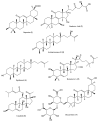

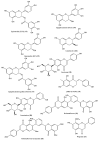
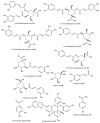
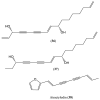
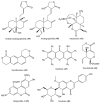






Similar articles
-
The impact of the hepatitis B virus polymerase rtA181T mutation on replication and drug resistance is potentially affected by overlapping changes in surface gene.J Virol. 2014 Jun;88(12):6805-18. doi: 10.1128/JVI.00635-14. Epub 2014 Apr 2. J Virol. 2014. PMID: 24696492 Free PMC article.
-
Nobiletin, a novel inhibitor, inhibits HBsAg production and hepatitis B virus replication.Biochem Biophys Res Commun. 2020 Mar 12;523(3):802-808. doi: 10.1016/j.bbrc.2019.12.099. Epub 2020 Jan 15. Biochem Biophys Res Commun. 2020. PMID: 31954513
-
β-Thujaplicinol inhibits hepatitis B virus replication by blocking the viral ribonuclease H activity.Antiviral Res. 2013 Sep;99(3):221-9. doi: 10.1016/j.antiviral.2013.06.007. Epub 2013 Jun 21. Antiviral Res. 2013. PMID: 23796982
-
Drug targets in hepatitis B virus infection.Infect Disord Drug Targets. 2009 Apr;9(2):105-16. doi: 10.2174/187152609787847677. Infect Disord Drug Targets. 2009. PMID: 19275699 Free PMC article. Review.
-
[Research progress on the effect of hepatitis B virus DNA integration on antiviral therapy].Zhonghua Gan Zang Bing Za Zhi. 2024 Apr 20;32(4):375-379. doi: 10.3760/cma.j.cn501113-20230724-00017. Zhonghua Gan Zang Bing Za Zhi. 2024. PMID: 38733195 Review. Chinese.
Cited by
-
Structural and Synthetic Aspects of Small Ring Oxa- and Aza-Heterocyclic Ring Systems as Antiviral Activities.Viruses. 2023 Aug 28;15(9):1826. doi: 10.3390/v15091826. Viruses. 2023. PMID: 37766233 Free PMC article. Review.
References
-
- Qin Y.-L., Li B., Zhou Y.-S., Zhang X., Li L., Song B., Liu P., Yuan Y., Zhao Z.-P., Jiao J., et al. Chinese Military Medical Experts Group in Sierra, L., Prevalence and associated knowledge of hepatitis B infection among healthcare workers in Freetown, Sierra Leone. BMC Infect. Dis. 2018;18:315. doi: 10.1186/s12879-018-3235-1. - DOI - PMC - PubMed
Publication types
MeSH terms
Substances
LinkOut - more resources
Full Text Sources
Medical

